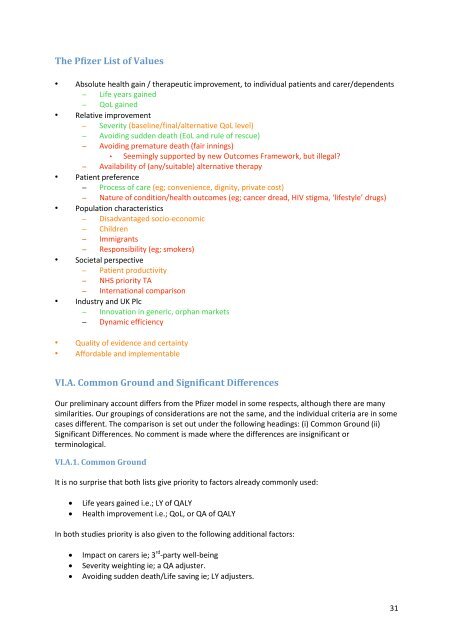What Values Should Count in Value Based Pricing for the NHS - UCL
What Values Should Count in Value Based Pricing for the NHS - UCL
What Values Should Count in Value Based Pricing for the NHS - UCL
You also want an ePaper? Increase the reach of your titles
YUMPU automatically turns print PDFs into web optimized ePapers that Google loves.
The Pfizer List of <strong><strong>Value</strong>s</strong><br />
• Absolute health ga<strong>in</strong> / <strong>the</strong>rapeutic improvement, to <strong>in</strong>dividual patients and carer/dependents<br />
– Life years ga<strong>in</strong>ed<br />
– QoL ga<strong>in</strong>ed<br />
• Relative improvement<br />
– Severity (basel<strong>in</strong>e/f<strong>in</strong>al/alternative QoL level)<br />
– Avoid<strong>in</strong>g sudden death (EoL and rule of rescue)<br />
– Avoid<strong>in</strong>g premature death (fair <strong>in</strong>n<strong>in</strong>gs)<br />
• Seem<strong>in</strong>gly supported by new Outcomes Framework, but illegal?<br />
– Availability of (any/suitable) alternative <strong>the</strong>rapy<br />
• Patient preference<br />
– Process of care (eg; convenience, dignity, private cost)<br />
– Nature of condition/health outcomes (eg; cancer dread, HIV stigma, ‘lifestyle’ drugs)<br />
• Population characteristics<br />
– Disadvantaged socio‐economic<br />
– Children<br />
– Immigrants<br />
– Responsibility (eg; smokers)<br />
• Societal perspective<br />
– Patient productivity<br />
– <strong>NHS</strong> priority TA<br />
– International comparison<br />
• Industry and UK Plc<br />
– Innovation <strong>in</strong> generic, orphan markets<br />
– Dynamic efficiency<br />
• Quality of evidence and certa<strong>in</strong>ty<br />
• Af<strong>for</strong>dable and implementable<br />
VI.A. Common Ground and Significant Differences<br />
Our prelim<strong>in</strong>ary account differs from <strong>the</strong> Pfizer model <strong>in</strong> some respects, although <strong>the</strong>re are many<br />
similarities. Our group<strong>in</strong>gs of considerations are not <strong>the</strong> same, and <strong>the</strong> <strong>in</strong>dividual criteria are <strong>in</strong> some<br />
cases different. The comparison is set out under <strong>the</strong> follow<strong>in</strong>g head<strong>in</strong>gs: (i) Common Ground (ii)<br />
Significant Differences. No comment is made where <strong>the</strong> differences are <strong>in</strong>significant or<br />
term<strong>in</strong>ological.<br />
VI.A.1. Common Ground<br />
It is no surprise that both lists give priority to factors already commonly used:<br />
<br />
<br />
Life years ga<strong>in</strong>ed i.e.; LY of QALY<br />
Health improvement i.e.; QoL, or QA of QALY<br />
In both studies priority is also given to <strong>the</strong> follow<strong>in</strong>g additional factors:<br />
<br />
<br />
<br />
Impact on carers ie; 3 rd ‐party well‐be<strong>in</strong>g<br />
Severity weight<strong>in</strong>g ie; a QA adjuster.<br />
Avoid<strong>in</strong>g sudden death/Life sav<strong>in</strong>g ie; LY adjusters.<br />
31
















